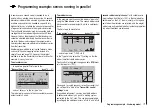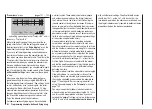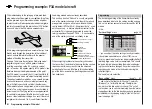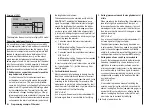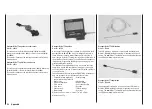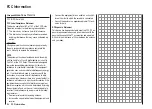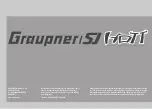
191
Programming example: model helicopter
ch1
ch1
ptch
thro
tail
normal
gyro
0%
inp8
0%
Please be sure to read and observe the set-up
instructions supplied with your gyro at this point,
as there is a possibility that your helicopter will be
uncontrollable if you set it up incorrectly!
If your gyro features gain control from the transmitter -
unlike the type we are using in this example - you will
need another free proportional control for it, e. g. CTRL
7. This can be assigned to the “Gyro” input in the …
“Transmitter control settings”
menu
+
trv
free
free
ctrl 6
ctrl 7
I5
thr
gyr
I8
lim
+100% +100%
+100% +100%
+100% +100%
+100% +100%
+100% +100%
free
Turn the rotary control until its number (transmitter
control number) appears on the screen, then use the ar-
row button
of the left or right-hand touch-key to move
to the
ASY
field in the “Travel” column. Briefly press the
central
SET
button of the right-hand touch-key, and you
will be able to set a maximum gyro gain such as 50% in
the now highlighted field:
+
+100% +100%
+100% +100%
+100% +100%
+100% +100%
+50% +50%
trv
free
free
ctrl 6
ctrl 7
I5
thr
gyr
I8
lim
free
This represents a safe fixed value which is maintained
as long as the rotary control is at its right-hand end-stop.
You will probably need to adjust the value in the course
of flight-testing. Additional notes on setting up gyros can
be found on pages 118 / 119.
Further adjustments
If you have followed this programming example, you will
have a helicopter which is set up properly, and in an
ideal state for hovering practice and simple circuits. Of
course, you may wish to activate further functions de-
pending on your skill and flying experience. If you wish
to fly using different rotor speeds and trim set-ups, you
will need to activate a series of “flight phases”, which
can be called up via switches which you assign. The first
step in this process is to call up the …
“Base settings”
menu
pitch min
rear
timer
10:01
C3
phase 2
phase 3
hover
acro
autorotat.
2
–––
8
… assign a switch to “Phase 2”, e. g. SW 8, and enter a
relevant name (if you wish).
It is important to be quite clear in your mind that auto-
rotation always has
absolute precedence
over any
other phases. This simply means: if you operate the
auto-rotation switch, you immediately move to the auto-
rotation phase from either of the other two flight phases
(“normal” phase and “phase 2”).
Now move back to the “
Helimix
” menu, switch to “Phase
2” (which you have just set up), and modify the settings
accordingly. Since the
mx-16
HoTT features digital
trims, in the Heli program all the trim positions for the
control functions “roll”, “pitch-axis” and “tail rotor” are
stored separately for each flight phase, in addition to the
other menu settings which you entered separately for
each flight phase (see page 114).
For example, if the motor run is limited by the fueltank
size or battery capacity, you should set the stopwatch
to count down. Enter the maximum possible motor run
time, e. g. “5 min.”. The transmitter’s sounder now starts
emitting warning sounds starting at “30 s” before “zero”,
as described on page 86. You could assign the transmit-
ter control switch “G3” to this timer, by first activating
switch assignment and then turning the throttle limit con-
trol from its idle position in the direction of full-throttle:
rotor direct
swashplate
right
3sv(2rol)
cut off
–100% +150% 1
pitch min
rear
timer
5:00
C3
With the stopwatch halted, touch the
or
but-
tons of the left-hand touch-key (
CLEAR
) simultaneously
at the basic display, so that the stopwatch switches to
the “Timer” function. The timer then starts automatically
when you move the throttle limit slider towards full-
Summary of Contents for mx-12 Hott
Page 1: ...Programming Manual 33116 mx 16 HoTT 3 en mx 16...
Page 35: ...35 For your notes...
Page 49: ...49 For your notes...
Page 55: ...55 For your notes...
Page 59: ...59 For your notes...
Page 63: ...63 For your notes...
Page 69: ...69 For your notes...
Page 91: ...91 For your notes...
Page 101: ...101 For your notes...
Page 123: ...123 For your notes...
Page 181: ...181 For your notes...
Page 193: ...193 For your notes...

